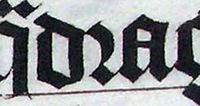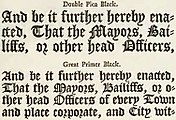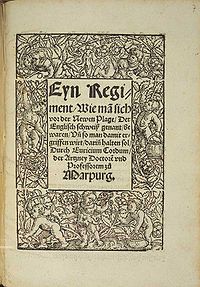Round r
The round r (also called r rotunda ) is a variant of the letter r in broken fonts . It was originally created by using a shape matching the curvature of the "o" in the letter combination "or", which resembled the uppercase form of the "R" without a vertical line. Later it was also used after other letters with rounding on the right side (b, d, h, p) and with the double r ("rr") as an alternative to the normal r.
application
In contrast to the long s (ſ), the use of the round r is not determined by orthographic or typographic rules. Therefore, as far as its use is purely aesthetic, it must be entered in word processing programs as a normal "r" and not as a special character. It can then be applied automatically depending on the choice of font , e.g. B. by using OpenType rules for glyph substitutions stored in the font file .
However, special applications (e.g. in medieval studies and palaeography ) require that the round r be viewed as a separate letter in their context, which must be clearly identifiable in the text itself, regardless of the selected font. Especially for such purposes, it has been included in Unicode since version 5.1 in the Latin, extended-D block . In order to be able to use it in quotations even if they are completely capitalized , a capitalized form was added, the necessity of which was otherwise not based on the sources. Its inclusion in Unicode also meant that Antiqua forms were developed so that the character could be incorporated into popular fonts.
The Unicode positions are:
- Capital letter: U + A75A latin capital letter r rotunda (Ꝛ)
- Small letter : U + A75B latin small letter r rotunda (ꝛ)
Use as an abbreviation for "and"

A similar or identical glyph was also used as an abbreviation for "and". The origin of this use lies in the Tironic note for et (Latin "and"). This ⁊ was initially included in many scripts as a separate glyph, later the glyph of the rather similar round r was used in many cases. The abbreviation " etc. " has been used for the longest time (see illustrations).

The author Helmut Delbanco put forward the thesis that the ⁊ c written with a round r could also be read as rc and understood as an abbreviation for Latin relinquo cetera ("I leave more things out"), which would largely be equivalent to et cetera (analogously " and so on ”).
Examples

Excerpt: q [ua] drag… (= quadraginta ) in a Bible manuscript from Malmesbury ( Textura ), 1407
Examples with round r after o in a type sample book by William Caslon I, London 1763
Word , writing and Mr. (Alte Schwabacher ), computer typesetting
Title page of a book by Euricius Cordus on English sweat , 1529
See also
- Long s
- Г , Cyrillic letter, the italic (handwritten) form of the lower case letter ( г ) is similar to the round r.
literature
- Eberhard Dilba: Typography lexicon and reader for everyone . With examples of spellings in typesetting. 2nd Edition. Books on Demand, Norderstedt 2008, ISBN 978-3-8334-2522-6 (bibliography pp. 131-134).
Web links
Individual evidence
- ^ Michael Everson et al: Proposal to add medievalist characters to the UCS. (PDF; 3.8 MB) ISO / IEC JTC1 / SC2 / WG2, January 30, 2006, p. 3 , accessed on July 19, 2012 (English): “In any case, Welsh and Nordic medievalists distinguish R from R ROTUNDA in their printed editions ... "
- ↑ Latin Extended-D - Range: A720 – A7FF . In: Unicode, Inc. (Ed.): The Unicode Standard, Version 5.1. 2008, p. 446–447 ( online [PDF; 105 kB ; accessed on August 22, 2009]).
- ↑ Bernhard Schnelle: Broken Writings. Retrieved January 20, 2014 .




